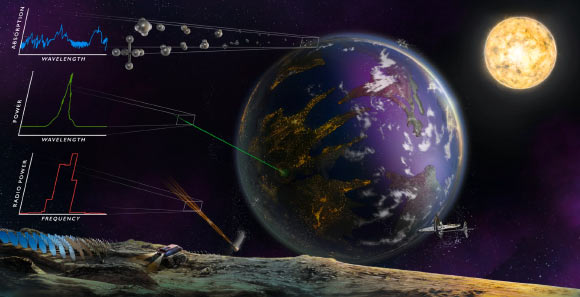Astrobiologists Identify Five Greenhouse Gases that Would Be Giveaways of Terraformed Exoplanet

Top Stories Tamfitronics
The five artificial greenhouse gases identified by University of California, Riverside astrobiologist Edward Schwieterman and his colleagues would be detectable even at relatively low concentrations in the atmospheres of exoplanets using the NASA/ESA/CSA James Webb Space Telescope and future space-based telescopes.
An illustration of various planetary technosignatures, including artificial atmospheric gases. Image credit: Sohail Wasif / UC Riverside.
“For us, these gases are bad because we don’t want to increase warming,” Dr. Schwieterman said.
“But they’d be good for a civilization that perhaps wanted to forestall an impending ice age or terraform an otherwise-uninhabitable planet in their system, as humans have proposed for Mars.”
“Since these gases are not known to occur in significant quantities in nature, they must be manufactured.”
“Finding them, therefore, would be a sign of intelligent, technology-using life forms. Such signs are called technosignatures.”
The five gases proposed by the authors are used on Earth in industrial applications such as making computer chips.
They include fluorinated versions of methane, ethane, and propane, along with gases made of nitrogen and fluorine or sulfur and fluorine.
One advantage is that they are incredibly effective greenhouse gases. Sulfur hexafluoride, for example, has 23,500 times the warming power of carbon dioxide. A relatively small amount could heat a freezing planet to the point where liquid water could persist on its surface.
Another advantage of the proposed gases — at least from an alien point of view — is that they are exceptionally long-lived and would persist in an Earth-like atmosphere for up to 50,000 years.
“They wouldn’t need to be replenished too often for a hospitable climate to be maintained,” Dr. Schwieterman said.
Others have proposed refrigerant chemicals, like CFCs, as technosignature gases because they are almost exclusively artificial and visible in Earth’s atmosphere.
However, CFCs may not be advantageous because they destroy the ozone layer, unlike the fully fluorinated gases discussed in the new paper, which are chemically inert.
“If another civilization had an oxygen-rich atmosphere, they’d also have an ozone layer they’d want to protect,” Dr. Schwieterman said.
“CFCs would be broken apart in the ozone layer even as they catalyzed its destruction.”
“As they’re more easily broken apart, CFCs are also short-lived, making them harder to detect.”
Finally, the fluorinated gases have to absorb infrared radiation to have an impact on the climate.
That absorption produces a corresponding infrared signature that could be detectable with space-based telescopes.
With current or planned technology, scientists could detect these chemicals in certain nearby exoplanetary systems.
“With an atmosphere like Earth’s, only one out of every million molecules could be one of these gases, and it would be potentially detectable. That gas concentration would also be sufficient to modify the climate,” Dr. Schwieterman said.
To arrive at this calculation, the astrobiologists simulated a planet in the TRAPPIST-1 systemabout 40 light-years away from Earth.
They chose this system, which contains at least seven rocky planets, because it is one of the most studied planetary systems aside from our own.
While they cannot quantify the likelihood of finding the artificial greenhouse gases in the near future, they are confident that — if they are present — it is entirely possible to detect them during currently planned missions to characterize planetary atmospheres.
“You wouldn’t need extra effort to look for these technosignatures, if your telescope is already characterizing the planet for other reasons,” Dr. Schwieterman said.
“And it would be jaw-droppingly amazing to find them.”
The team’s work was published in the Astrophysical Journal.
_____
Edward W. Schwieterman et al. 2024. Artificial Greenhouse Gases as Exoplanet Technosignatures. ApJ 969, 20; two: 10.3847/1538-4357/ad4ce8
Discover more from Tamfis Nigeria Lmited
Subscribe to get the latest posts sent to your email.



 Hot Deals
Hot Deals Shopfinish
Shopfinish Shop
Shop Appliances
Appliances Babies & Kids
Babies & Kids Best Selling
Best Selling Books
Books Consumer Electronics
Consumer Electronics Furniture
Furniture Home & Kitchen
Home & Kitchen Jewelry
Jewelry Luxury & Beauty
Luxury & Beauty Shoes
Shoes Training & Certifications
Training & Certifications Wears & Clothings
Wears & Clothings

















